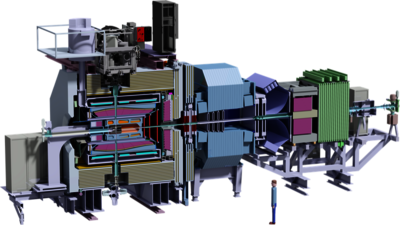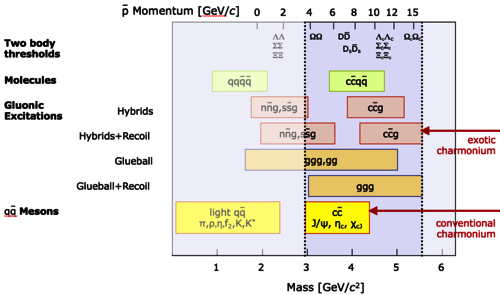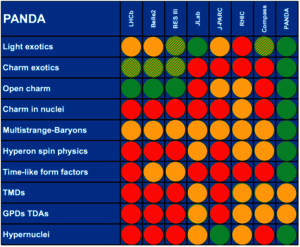The PANDA Experiment is the main task of GSI hadron physics and the ultimate work horse for the future of hadron physics world-wide. It uses a versatile detector and will be one of the key experiments at the Facility for Antiproton and Ion Research (FAIR) which is under construction and currently being built on the area of the GSI Helmholtzzentrum für Schwerionenforschung in Darmstadt, Germany. Antiprotons produced by a primary proton beam will then be filled into the High Energy Storage Ring (HESR) which collide with the fixed proton or nuclear target inside the PANDA detector to investigate the structure and dynamics of hadrons.
The annihilation of antiprotons with protons offers the precise spectroscopy of all states in the charmonium system, the search for glueballs, multi-quark systems and mesonic hybrid states in the mass region above 3 GeV/c2. With targets containing heavier nuclei also the impact of dense nuclear matter can be studied in open and hidden charm states. Furthermore quark dynamics in hadrons, the production and spectroscopy of (double) hypernuclei, as well as particular questions of the proton structure are part of the versatile research program. The assembly of the respective universal detector PANDA is already in full swing.
Development and Coordination
PANDA coordination and hostlab activities
- Technical coordination of the PANDA experiment (together with FAIR)
- Panda-Hall coordination (together with FAIR)
- Adminstrative management of the PANDA collaboration
PANDA development and construction
- DIRC (Cherenkov Detector) barrel-part for the target spectrometers
- Software trigger and framework for simulation and reconstruction
- EMC (Electromagnetic calorimeter) ASIC preamps and LAAPD screening facility
- Frontend Readout
Hadronphysics
The HESR is planned to deliver a stored and cooled antiproton beam from P=0.5 GeV/c to 15 GeV/c. Since beam and target particles annihilate, their full inertial mass adds to the total center-of-mass energy (which spans from 2 to 5.5 GeV/c2) is available for physics. Thus all conventional and exotic hadrons with u-,d-,s-, and in particular c-quarks are reachable. b-hadrons would be accessible only with a proton-antiproton collider.
In addition it is possible to cover an intersting area in proton structure physics and the formation of single and double hypernuclei by implanting lambdas from the proton-antiproton annihilation into a nucleus.
The physics interest at GSI is
- hadron spectroscopy: together with the Goethe-University Frankfurt development of trigger algorithms, analysis strategies and software for amplitude analsyis, and
- hadron structure: development of analysis strategies and software together with the HI Mainz.
The world-wide perspective
- The very structure of hadrons is more unclear as it was ever before.
- The many new results pose more questions than they actually explain.
- PANDA is unique in combining the potential for the discovery of new physics with the ability to carry out precise, systematic measurements.
- The experimental programs spectroscopy, structure and interactions present many synergies and can in most cases be carried out in parallel.
- The capabilities of PANDA are in fact timeless and complementary with respect to other competiting technologies or experiments
- Thus the experiment will yield excellent physics for the next deca
Please visit for more information our presentation to the FAIR Science Council
for more information about the science case and its comptetiveness in the word-wide context.







